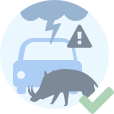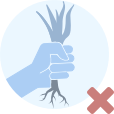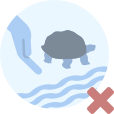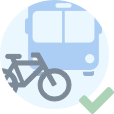
Go to our visitor centres, information points and ecomuseums to get the most out of your visit.
Companies authorised to conduct visits must submit an application in one of the following ways:
(a) General electronic submission of documents. A digital certificate or Cl@ve is required. (Click HERE to access) Address the application to the Paraje Natural Marismas del Odiel.
b) Presentation in the general registry of the Territorial Delegation of Sustainability, Environment in Huelva, located in Calle Sanlúcar de Barrameda 3 - 21071- Huelva.
c) Submission through any of the means indicated in article 16.4 of Law 39/2015, in which case it must be done further in advance to facilitate the transfer of the documentation between the administrations involved.
This path runs through a marsh and is totally free from the influence of the tide. As in the El Almendral area, human activity is evident.
The starting point of the Acebuchal hiking trail is located a few metres from the El Almendral hiking trail, along the Dique Juan Carlos I road. It follows a route along the spit of the same name. It is a narrow strip of consolidated sands completely surrounded by marshes and floodplains. The hiking trail follows a route running parallel to the El Acebuchal channel, which constitutes the northern limit of the spit, so that most of the forest mass that has colonised this extension of emerged land extends to the left of the route. In this case, the plant domain is made up of tree species that tolerate the salinity of the environment such as stone pine, maritime juniper and wild olive. Under the cover of the trees there are hardly any remains of scrub, having been replaced by cereal pastures due to the use by livestock in this part of the marsh.
On the other side of the path, the Estero del Acebuchal marsh extends and the vegetation is limited to the riverbanks where several halophyte species, capable of resisting high levels of salinity in the substrate, grow, these are principally arthrocnemum macrostachyum, espartina and salicornia.
We can easily see the use by livestock such as sheep and horses, which has conditioned the evolution of the vegetation, as well as the proximity of cereal crops and a eucalyptus forest.






From the Huelva-Punta Umbría motorway (A-497), take the exit signposted towards the Marismas del Odiel Natural Park and that does not lead to the Juan Carlos I Dike motorway. Continue along it and, after crossing the Puente del Burro, after about 2 km you will find the trail start sign and the limited access gate.

Go to our visitor centres, information points and ecomuseums to get the most out of your visit.

Do not disturb or feed the animals. You would negatively alter their behavior.

Check the weather forecast before starting your activity.

Bring water, sun protection, suitable clothing and footwear.

Bring a mobile phone with enough battery in case of emergency (112), but remember that there is not always coverage.

For your safety and that of the environment, do not go off the signposted trail or take shortcuts.

Extreme caution in adverse conditions and in the occasional presence of animals or motor vehicles.

Follow the recommendations and comply with the regulations at all times

Respect the facilities put at your disposal. We all pay for its maintenance.

Help prevent fires. Do not throw cigarettes or any other object that produces combustion.

Trash doesn't come back alone. Take it with you to the nearest container. Reduce, reuse, recycle.

Avoid going out alone. If you do, communicate the route and time of return to other people.

Noise is another form of pollution. In silence you will enjoy your experience more.

Live respectfully with the locals and other users. Respect private property.

Facilitate use for people with special needs.

By consuming local products and counting on local companies, you will contribute to rural development.

Practice responsible tourism and committed to the environment. Be a true ecotourist!

Never leave your pet in the wild. It would endanger the flora and fauna of the place.

Get around in a sustainable way: public transport, bicycle, on foot, electric or shared vehicle ... Park in the designated places

Do not leave a trace of your passage through nature. The best memory you can take with you is your own photograph.

Your safety is our concern, but it is your responsibility.

The conservation of natural spaces is also in your hands. Thank you for your collaboration!

Find out in advance about the possible existence of hunting activity and remember that all public use facilities are declared safety zones.